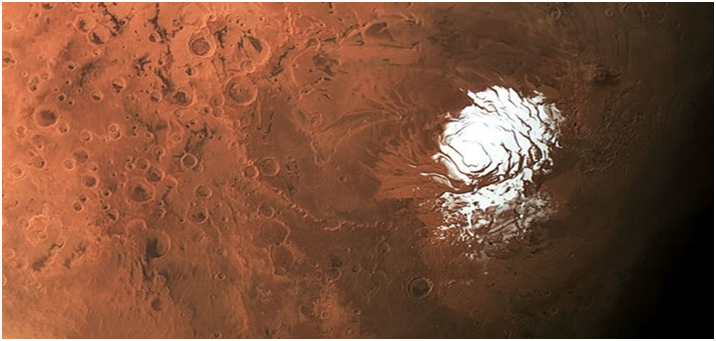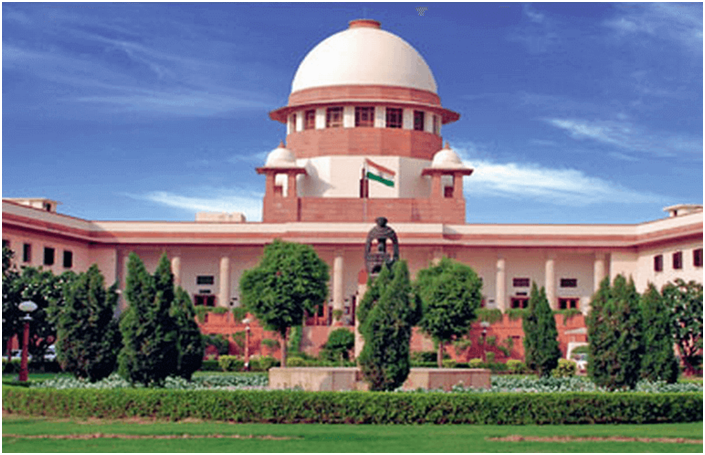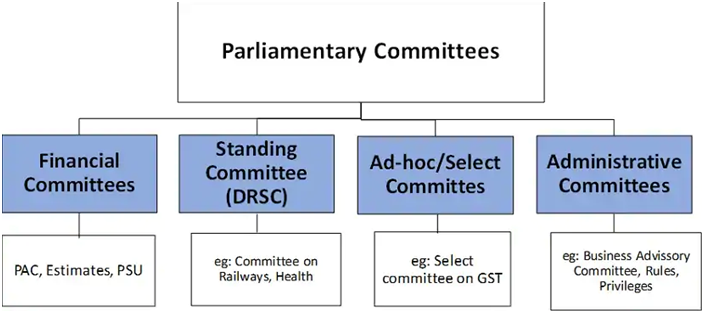New evidence for liquid water discovered on Mars (GS Paper 3, Science and Tech)

Why in news?
- New data has been uncovered by an international team of researchers that suggests there may be liquid water beneath Mars’ south polar ice cap.
Key Findings:
- To find subtle patterns in the height of the ice cap, the researchers, led by the University of Cambridge with participation from the University of Sheffield, used laser-altimeter measurements of the shape of the upper surface of the ice cap.
- They then showed that these patterns match computer model predictions for how a body of water beneath the ice cap would affect the surface.
- Their results are in agreement with earlier ice-penetrating radar measurements that were originally interpreted to show a potential area of liquid water beneath the ice.
Diff between polar ice caps on Earth & Mars:
- Like Earth, Mars has thick water ice caps at both poles, roughly equivalent in combined volume to the Greenland Ice Sheet.
- However, unlike Earth’s ice sheets which are underlain by water-filled channels and even large subglacial lakes, the polar ice caps on Mars have until recently been thought to be frozen solid all the way to their beds due to the cold Martian climate.
- On Earth, subglacial lakes affect the shape of the overlying ice sheet and its surface topography. The water in subglacial lakes lowers friction between the ice sheet and its bed, affecting the velocity of ice flow under gravity.
- This in turn affects the shape of the ice sheet surface above the lake, often creating a depression in the ice surface followed by a raised area further down-flow.
MARSIS:
- In 2018, evidence from the European Space Agency’s Mars Express satellite challenged this assumption.
- The satellite has an ice-penetrating radar called MARSIS, which can see through Mars’ southern ice cap. It revealed an area at the base of the ice that strongly reflected the radar signal, which was interpreted as an area of liquid water beneath the ice cap.
- However, subsequent studies suggested that other types of dry materials, which exist elsewhere on Mars, could produce similar patterns of reflectance if they exist beneath the ice cap.
Recent research:
- The team used a range of techniques to examine data from NASA’s Mars Global Surveyor satellite of the surface topography of the part of Mars’ south polar ice cap where the radar signal was identified.
- Their analysis revealed a 10-15 kilometre-long surface undulation comprising a depression and a corresponding raised area, both of which deviate from the surrounding ice surface by several metres. This is similar in scale to undulations over subglacial lakes here on Earth.
- The team then tested whether the observed undulation on the surface of the ice could be explained by liquid water at the bed.
- They ran computer model simulations of ice flow, adapted to specific conditions on Mars. They then inserted a patch of reduced bed friction in the simulated ice sheet bed where water, if present, would allow the ice to slide and speed up.
Geothermal heat:
- The researchers also varied the amount of geothermal heat coming from inside the planet. These experiments generated undulations on the simulated ice surface that were similar in size and shape to those the team observed on the real ice cap surface.
- The similarity between the model-produced topographic undulation and the actual spacecraft observations, together with the earlier ice-penetrating radar evidence suggests that there is an accumulation of liquid water beneath Mars’ south polar ice cap.
- This magmatic activity occurred relatively recently in the subsurface of Mars to enable the enhanced geothermal heating needed to keep the water in a liquid state.
India emerges as the worlds largest producer and consumer of sugar
(GS Paper 3, Economy)
Why in news?
- India has emerged as the world’s largest producer and consumer of sugar as well as the world’s 2nd largest exporter of sugar.

Details:
- In Sugar Season (Oct-Sep) 2021-22, a record of more than 5000 Lakh Metric Tons (LMT) sugarcane was produced in the country out of which about 3574 LMT of sugarcane was crushed by sugar mills to produce about 394 LMT of sugar (Sucrose).
- Out of this, 35 LMT sugar was diverted to ethanol production and 359 LMT sugar was produced by sugar mills.
2021-2022 boon for Indian Sugar Sector:
- All records of sugarcane production, sugar production, sugar exports, cane procured, cane dues paid and ethanol production were made during the season.
- Another shining highlight of the season is the highest exports of about 109.8 LMT that too with no financial assistance which was being extendedupto 2020-21.
- Supportive international prices and Indian Government Policy led to this feat of Indian Sugar Industry. These exports earned foreign currency of about Rs. 40,000 crores for the country.
Collaborative effort:
- The success story of sugar industry is the outcome of synchronous and collaborative efforts of Central and State Governments, farmers, sugar mills, ethanol distilleries with very supportive overall ecosystem for business in the country.
- Timely Government interventions since last 5 years have been crucial in building the sugar sector step by step from taking them out of financial distress in 2018-19 to the stage of self-sufficiency in 2021-22.
Ethanol production:
- Growth of ethanol as biofuel sector in last 5 years has amply supported the sugar sector as use of sugar to ethanol has led to better financial positions of sugar mills due to faster payments, reduced working capital requirements and less blockage of funds due to less surplus sugar with mills.
- During 2021-22, revenue of about ₹ 18,000 crore has been made by sugar mills/distilleries from sale of ethanol which has also played its role in early clearance of cane dues of farmers.
- Ethanol production capacity of molasses/sugar-based distilleries has increased to 605 crore litres per annum and the progress is still continuing to meet targets of 20% blending by 2025 under Ethanol Blending with Petrol (EBP) Programme.
- In new season, the diversion of sugar to ethanol is expected to increase from 35 LMT to 50 LMT which would generate revenue for sugar mills amounting to about ₹ 25,000 crores.
Way Forward:
- The diversion of sugar to ethanol and exports led to unlocking of value chain of the whole industry as well as improved financial conditions of sugar mills leading to more optional mills in ensuing season.
The criterion for SC status
(GS Paper 2, Judiciary)
Why in news?
- The Supreme Court of India has sought the most recent position of the Union government on a batch of petitions challenging the Constitution (Scheduled Castes) Order of 1950, which allows only members of Hindu, Sikh and Buddhist religions to be recognised as SCs.
Who all are included in the Constitution Order of 1950?
- When enacted, the Constitution (Scheduled Castes) Order of 1950, initially provided for recognising only Hindus as SCs, to address the social disability arising out of the practice of untouchability.
- The Order was amended in 1956 to include Dalits who had converted to Sikhism and once more in 1990 to include Dalits who had converted to Buddhism.
- Both amendments were aided by the reports of the Kaka Kalelkar Commission in 1955 and the High Powered Panel (HPP) on Minorities, Scheduled Castes and Scheduled Tribes in 1983 respectively.
- On the other hand, the Union government in 2019 rejected the possibility of including Dalit Christians as members of SCs, rooting the exclusion on an Imperial Order of 1936 of the then colonial government, which had first classified a list of the Depressed Classes and specifically excluded “Indian Christians” from it.

Why are Dalit Christians excluded?
- Ever since the amendment to include Sikhs as SCs in 1956, the Office of the Registrar General of India (RGI) has been reluctant in expanding the ambit of the Order beyond members of Hinduism or Sikhism.
- Responding to the Ministry of Home Affairs’s (MHA) 1978 request for an opinion on the inclusion of Dalit Buddhists and Christians, the RGI had cautioned the government that SC status is meant for communities suffering from social disabilities arising out of the practice of untouchability, which it noted was prevalent in Hindu and Sikh communities. It also noted that such a move would significantly swell the population of SCs across the country.
- However, the amendment to include Buddhist converts as SCs was passed in 1990, which at the time did not require the approval of the RGI — a mandate introduced in the rules for inclusion framed in 1999.
- In 2001, when the RGI again opined against including Dalit Christians and Muslims as SCs, it referred to its 1978 note and added that like Dalit Buddhists, Dalits who converted to Islam or Christianity belonged to different sets of caste groups and not just one, as a result of which they cannot be categorised as a “single ethnic group”, which is required by Clause (2) of Article 341 for inclusion.
- Moreover, the RGI opined that since the practice of “untouchability” was a feature of Hindu religion and its branches, allowing the inclusion of Dalit Muslims and Dalit Christians as SCs could result in being “misunderstood internationally” as India trying to “impose its caste system” upon Christians and Muslims.
- The 2001 note also stated that Christians and Muslims of Dalit origin had lost their caste identity by way of their conversion and that in their new religious community, the practice of untouchability is not prevalent.
Is there a case for inclusion?
- The petitions arguing for inclusion have cited several independent Commission reports that have documented the existence of caste and caste inequalities among Indian Christians and Indian Muslims, noting that even after conversion, members who were originally from SCs continued to experience the same social disabilities.
- This was substantiated in the First Backward Classes Commission’s report in 1953, the Report of the Committee on Untouchability Economic and Educational Development Of the Scheduled Castes in 1969, the HPP report on SCs, STs, and Minorities in 1983, the Mandal Commission Report, the report of the Prime Minister’s High-Level Committee formed in 2006, a 2008 study conducted by the National Commission for Minorities, the RanganathMisra Commission Report and several other studies.
- In addition to this, the petitions have argued against the proposition that caste identity is lost upon conversion, noting that even in Sikhism and Buddhism, casteism is not present and yet they have been included as SCs.
- Furthermore, the above-mentioned reports argue that caste-based discrimination continues even after conversion, hence entitling these communities to SC status. However, the Union government refuses to accept the reports of the Commissions on the basis that these reports do not have enough empirical evidence to support their claims.
Is this the first time the government has considered this issue?
- The closest a government has got to including Dalit Christians as SCs came in March, 1996, when based on a recommendation of the then Ministry of Welfare, the P. V. Narsimha Rao government first brought a Bill to amend the Constitution (Scheduled Castes) Order accordingly.
- When this could not be passed, the government within days attempted to include Dalit Christians as SCs through an Ordinance, which was sent to the President of India for assent after the due approval of the erstwhile Prime Minister, but could not then be promulgated.
- Following this failed attempt, the Atal Bihar Vajpayee government had in 2000 repeatedly sought the opinion of the Office of the RGI and the then National Commission for Scheduled Castes and Scheduled Tribes on whether Dalit Christians could be included. Both had recommended against the proposition.
- Apart from this, several attempts have been made from time to time by way of introducing Private Member Bills to amend the Constitution Order to include Dalit Christians and Dalit Muslims as SCs but these have all failed.
Parliament Committees & their role in law-making
(GS Paper 2, Polity and Governance)
Why in news?
- A revamp of the Standing Committees of Parliament could potentially worsen the relations between the government and opposition parties.
- Of the 22 committees announced recently, the Congress has the post of chairperson in only one, and the second largest opposition party, Trinamool Congress, none. The ruling BJP has the chairmanship of the important committees on Home, Finance, IT, Defence and External Affairs.
What are Committees of Parliament?
- Legislative business begins when a Bill is introduced in either House of Parliament. But the process of lawmaking is often complex, and Parliament has limited time for detailed discussions.
- Also, the political polarisation and shrinking middle ground has been leading to increasingly rancorous and inconclusive debates in Parliament, as a result of which a great deal of legislative business ends up taking place in the Parliamentary Committees instead.
- A Parliamentary Committee is a panel of MPs that is appointed or elected by the House or nominated by the Speaker, and which works under the direction of the Speaker. It presents its report to the House or to the Speaker.
- Parliamentary Committees have their origins in the British Parliament.
- They draw their authority from Article 105, which deals with the privileges of MPs, and Article 118, which gives Parliament authority to make rules to regulate its procedure and conduct of business.
What are the various Committees of Parliament?
- Broadly, Parliamentary Committees can be classified into Financial Committees, Departmentally Related Standing Committees, Other Parliamentary Standing Committees, and Ad hoc Committees.
- The Financial Committees include the Estimates Committee, Public Accounts Committee, and the Committee on Public Undertakings. These committees were constituted in 1950.
Departmentally Related Standing Committees:
- Seventeen Departmentally Related Standing Committees came into being in 1993, when ShivrajPatil was Speaker of Lok Sabha, to examine budgetary proposals and crucial government policies.
- The aim was to increase Parliamentary scrutiny, and to give members more time and a wider role in examining important legislation.
- The number of Committees was subsequently increased to 24. Each of these Committees has 31 members — 21 from Lok Sabha and 10 from Rajya Sabha.

Ad hoc Committees:
- Ad hoc Committees are appointed for a specific purpose. They cease to exist after they have completed the task assigned to them, and have submitted a report to the House.
- The principal Ad hoc Committees are the Select and Joint Committees on Bills. Committees like the Railway Convention Committee, Committee on Food Management and Security in Parliament House Complex, etc. also come under the category of Ad hoc Committees.
- Parliament can also constitute a Joint Parliamentary Committee (JPC) with a special purpose, with members from both Houses, for detailed scrutiny of a subject or Bill. Also, either of the two Houses can set up a Select Committee with members from that House.
- JPCs and Select Committees are usually chaired by ruling party MPs, and are disbanded after they have submitted their report.
How do discussions/ debates in the Parliamentary Committees differ from those in Parliament?
- The time to speak on a Bill is allocated according to the size of the party in the House. MPs often do not get adequate time to put forward their views in Parliament, even if they are experts on the subject.
- Committees are small groups with relatively less demands on their time; in these meetings, every MP gets a chance and the time to contribute to the discussion. Parliament has only around 100 sittings a year; Committee meetings are independent of Parliament’s calendar.
- Also, because the discussions are confidential and off-camera, party affiliations usually do not come in the way of MPs speaking their minds in ways they are unable to do in Parliament, whose proceedings are telecast live and members are often constrained to speak to their constituencies.
- The Committees work closely with multiple Ministries, and facilitate inter-ministerial coordination. Bills that are referred to Committees often return to the House with significant value-addition.
- The Committees look into the demands for grants of Ministries/departments, examine Bills pertaining to them, consider their annual reports, and look into their long-term plans and report to Parliament.
How are the Committees constituted, and how are their chairpersons chosen?
- There are 16 Departmentally Related Standing Committees for Lok Sabha and eight for Rajya Sabha; however, every Committee has members from both Houses. Lok Sabha and Rajya Sabha panels are headed by members of these respective Houses.
- Among the important Lok Sabha panels are: Agriculture; Coal; Defence; External Affairs; Finance; Communications & Information Technology; Labour; Petroleum & Natural Gas; and Railways.
- The important Rajya Sabha panels include Commerce; Education; Health & Family Welfare; Home Affairs; and Environment.
- There are other Standing Committees for each House, such as the Business Advisory Committee and the Privileges Committee. The Presiding Officer of each House nominates members to these panels. A Minister is not eligible for election or nomination to Financial Committees, and certain Departmentally Related Committees.
How important are the recommendations of the Committees?
- Reports of Departmentally Related Standing Committees are recommendatory in nature. They are not binding on the government, but they do carry significant weight.
- In the past, governments have accepted suggestions given by the Committees and incorporated them into the Bill after it has come back to the House for consideration and passage.
- These panels also examine policy issues in their respective Ministries and make suggestions to the government. The government has to report back on whether these recommendations have been accepted. Based on this, the Committees table Action Taken Reports, detailing the status of the government’s action on each recommendation.
- However, suggestions by the Select Committees and JPCs which have a majority of MPs and heads from the ruling party are accepted more frequently.





